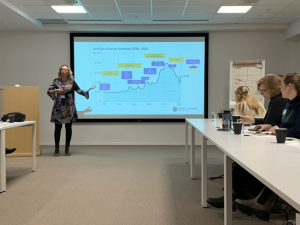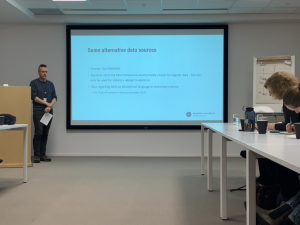Hai hai!
On January 19th, our class trekked out into the cold and ice to go visit one of the offices of the central statistics bureau in Norway, called Statistisk sentralbyrå or Statistics Norway. For most, this was one of many interesting site visits during our time in Oslo… but for this statistics nerd, it was my dream!
 We were able to hear three fascinating presentations from a variety of staff members, on gender statistics, LGBTQ+ quality of life, immigration trends, and Sámi statistics (or lack thereof). Gendering statistics is not something commonly discussed in an Introduction to Statistics course, but our presenters explain the compelling reasons why Norway considers gender in every analysis and is able to use statistics to understand the state of gender in Norway better. While Norway is a country notorious for its commitment to gender equality, statistical analysis can show us that there is still a significant gender divide in the labor market.
We were able to hear three fascinating presentations from a variety of staff members, on gender statistics, LGBTQ+ quality of life, immigration trends, and Sámi statistics (or lack thereof). Gendering statistics is not something commonly discussed in an Introduction to Statistics course, but our presenters explain the compelling reasons why Norway considers gender in every analysis and is able to use statistics to understand the state of gender in Norway better. While Norway is a country notorious for its commitment to gender equality, statistical analysis can show us that there is still a significant gender divide in the labor market.
We also learned that Norway is a country full of immigrants, who largely contribute to their population growth. With the war in Ukraine continuing, Norway will continue a decades-long trend of providing refugees a place to stay. We ended by learning about the difficulty of gaining statistical information related to the Sámi population in Norway. Due to the wide breadth of the Sámi community in Norway and a history of oppression from the Norwegian government, Sámi statistics give us more of a vague idea of Sámi in Norway rather than a truly representative analysis of the Sámi.


While statistics may not be everyone’s cup of tea, we cannot ignore that knowledge is power. Statistics allow people to truly understand what their country is and its state of affairs, irrespective of cultural and political notions. If you are interested in Statistics Norway’s work, please see their most recent comprehensive report This is Norway, 2021.
—
Stacie ’23
Women & Gender Studies, Data Science & Statistics, and Public Health Studies